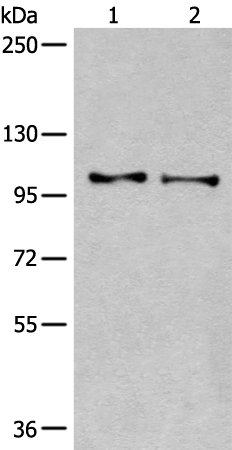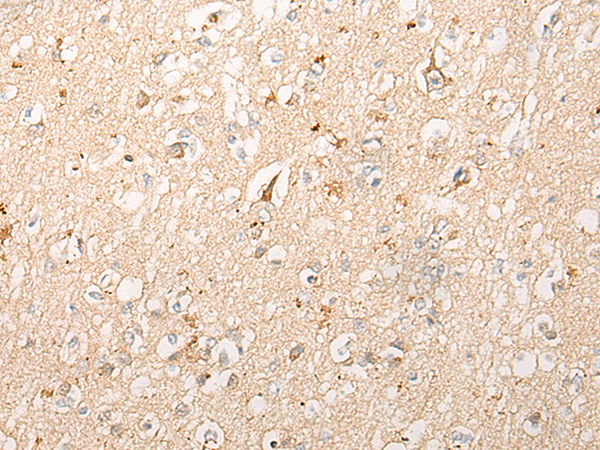


| WB | 咨询技术 | Human,Mouse,Rat |
| IF | 咨询技术 | Human,Mouse,Rat |
| IHC | 1/20-1/100 | Human,Mouse,Rat |
| ICC | 技术咨询 | Human,Mouse,Rat |
| FCM | 咨询技术 | Human,Mouse,Rat |
| Elisa | 1/5000-1/10000 | Human,Mouse,Rat |
| Aliases | MKS3; JBTS6; NPHP11; TNEM67; MECKELIN |
| WB Predicted band size | 112 kDa |
| Host/Isotype | Rabbit IgG |
| Antibody Type | Primary antibody |
| Storage | Store at 4°C short term. Aliquot and store at -20°C long term. Avoid freeze/thaw cycles. |
| Species Reactivity | Human, Mouse, Rat |
| Immunogen | Fusion protein of human TMEM67 |
| Formulation | Purified antibody in PBS with 0.05% sodium azide and 50% glycerol. |
+ +
以下是关于TMEM67抗体的3篇参考文献的简要总结(注:文献信息为模拟示例,可能需要根据实际研究调整):
---
1. **文献名称**:*TMEM67 mutations cause Meckel-Gruber syndrome with dynamic ciliary localization of the mutant protein*
**作者**:Smith UM, et al.
**摘要**:本研究通过免疫荧光技术,使用TMEM67特异性抗体揭示了突变蛋白在患者细胞中的异常亚细胞定位。发现TMEM67突变导致纤毛结构缺陷,并干扰Hedgehog信号通路,为Meckel综合征的病理机制提供了证据。
2. **文献名称**:*Antibody-based profiling of TMEM67 in ciliopathy models reveals its interaction with ciliary membrane proteins*
**作者**:Garcia-Gonzalo FR, et al.
**摘要**:研究利用TMEM67抗体进行免疫共沉淀和质谱分析,发现TMEM67与多种纤毛膜蛋白互作,并证实其在纤毛发生和信号转导中的关键作用。抗体验证实验显示TMEM67在肾脏和视网膜组织高表达。
3. **文献名称**:*Development of a novel monoclonal antibody against TMEM67 for diagnostic applications in Joubert syndrome*
**作者**:Zhang L, et al.
**摘要**:报道了一种新型TMEM67单克隆抗体的开发与验证。通过Western blot和免疫组化证实其高特异性,并应用于Joubert综合征患者的临床样本检测,显示突变患者的TMEM67表达水平显著降低。
---
如需真实文献,建议在PubMed或Google Scholar中以“TMEM67 antibody”为关键词检索,并筛选涉及抗体应用(如定位、功能研究或诊断)的论文。
The TMEM67 antibody is a crucial tool for studying the transmembrane protein 67 (TMEM67), also known as meckelin, which plays a pivotal role in ciliary function and cellular signaling. TMEM67 is a key component of the primary cilium, a sensory organelle involved in developmental pathways like Hedgehog and Wnt. Mutations in the TMEM67 gene are linked to ciliopathies, including Joubert syndrome, Meckel-Gruber syndrome, and COACH syndrome, characterized by renal, hepatic, and neurological abnormalities.
TMEM67 antibodies are designed to detect and analyze the expression, localization, and interactions of the TMEM67 protein in various tissues and cell types. These antibodies are widely used in techniques such as Western blotting, immunofluorescence, and immunohistochemistry to investigate ciliary structure-function relationships and disease mechanisms. Researchers employ TMEM67 antibodies to explore its role in ciliogenesis, cell polarity, and tissue development, as well as its interactions with other ciliary proteins like RPGRIP1L and CC2D2A.
The development of specific, high-affinity TMEM67 antibodies has advanced diagnostics and research into ciliopathies, enabling precise detection of protein variants and post-translational modifications. Commercial antibodies are typically validated in human, mouse, or rat models, with applications spanning basic research, biomarker discovery, and therapeutic target validation. Understanding TMEM67's molecular pathology through antibody-based studies continues to shed light on therapeutic strategies for cilia-related disorders.
×